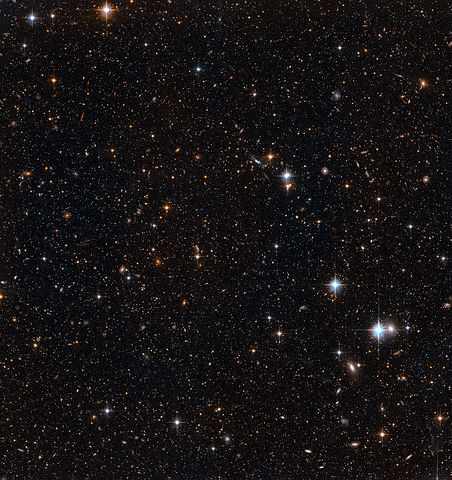 |
This is a file from the Wikimedia Commons. Information from its description page there is shown below.
Commons is a freely licensed media file repository. You can help.
|
Summary
| Description |
English: This image shows NASA/ESA Hubble Space Telescope images of a small part of the disc of the Andromeda Galaxy, the closest spiral galaxy to the Milky Way. Hubble’s position above the distorting effect of the atmosphere, combined with the galaxy’s relative proximity, means that the galaxy can be resolved into individual stars, rather than the cloudy white wisps usually seen in observations of galaxies.A galaxy’s disc is the area made up of its spiral arms, and the darker areas between them. After the galaxy’s central bulge, this is the densest part of a galaxy. However, these observations are made near the edge, where the star fields are noticeably less crowded. This lets us see glimpses through the galaxy into the distant background, where the more diffuse blobs of light are actually faraway galaxies. These observations were made in order to observe a wide variety of stars in Andromeda, ranging from faint main sequence stars like our own Sun, to the much brighter RR Lyrae stars, which are a type of variable star. With these measurements, astronomers can determine the chemistry and ages of the stars in each part of the Andromeda Galaxy.
|
| Date |
21 July 2011 |
| Source |
http://www.spacetelescope.org/images/heic1112a/ |
| Author |
NASA, ESA and T.M. Brown (STScI) |
Licensing

 |
This file is licensed under the Creative Commons Attribution 3.0 Unported license. |
|
| Attribution: ESA/Hubble |
- You are free:
- to share – to copy, distribute and transmit the work
- to remix – to adapt the work
- Under the following conditions:
- attribution – You must attribute the work in the manner specified by the author or licensor (but not in any way that suggests that they endorse you or your use of the work).
|
File usage
The following pages on Schools Wikipedia link to this image (list may be incomplete):
This file contains additional information, probably added from the digital camera or scanner used to create or digitize it. If the file has been modified from its original state, some details may not fully reflect the modified file.


